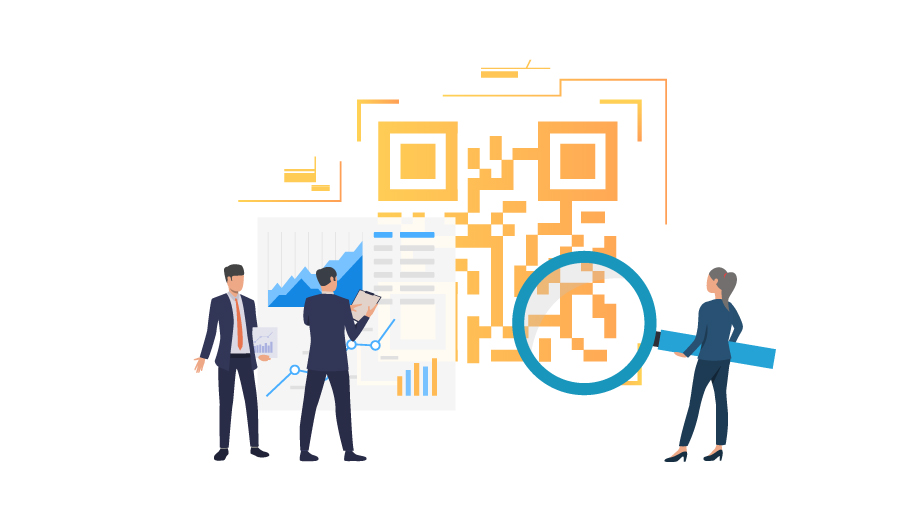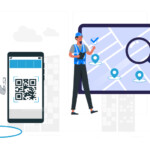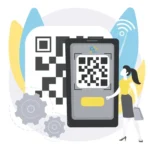QR Codes are ubiquitous today. They are being used in a wide array of applications. From being used in the pharmaceutical industry to prevent counterfeit drugs, the banking sector to avoid the wastage of paper from POS machines, goods, and services marketing, and eventually to monitor employees and staff schedules, QR Codes have been a ‘problem-solving catalyst’ whenever used appropriately.
Deloitte research says that 75% of the banks leading in digital transformation worldwide offer QR-based payment capabilities. To put it another way, another platform and reason for QR to keep growing exponentially in the years to come.
In context of field services, QR code tracking is the most common use case. From attendance monitoring to task tracking, QR codes play versatile roles in field workforce management. Read more about QR code tracking in this blog for efficient task management.

But what is a QR Code & its importance or uses?
A QRC, also known as a QR Code, is a machine-readable code consisting of black and white squares. And is capable of storing information that can be accessed by scanning it using any mobile or non-mobile device.
What is task monitoring and why is it important?
Task monitoring is the process of tracking, assessing, and modifying tasks performed by employees with the objective of having better control and management of people and processes.
Yes. task monitoring is not only important but could also be mandatory depending on the nature of the work, application, geography and compliance requirements.
Successful firms & bureaucracies both understand the importance and need for task tracking and hence there are guidelines developed for example by the American Bar Association to ensure that tracking isn’t overdone to the levels of invading employee privacy.
To understand this quickly, here are some key reasons task monitoring is important using time clock apps, scheduling apps, and time management software:
- Track Employee attendance to ensure fool-proof record-keeping and payroll calculation
- Monitoring task and project deadlines to ensure efficient execution of high-priority tasks and projects
- Correctly budgeted timesheet creation to prevent any incorrect salary or wage payments to the employees
- Eliminate time theft by catching discrepancies
- Boost productivity by ironing out human errors
- Quantifiable employee assessment for performance assessments
- Increased accountability by using data-driven time management software
If you still use paper-based or a legacy clock-in clock-out software, then efficient time management software, preferably with QR compatibility, should be the next quick step.
What is QR code tracking?
QR Code tracking is the process of monitoring QR Code scan performance by its users and the user insights to conduct business more efficiently, with greater control, lesser risk, and more accountability.
It can be used to identify factors including but not limited to:
- Number of users that scanned the code
- Individual identities, designation, and role of the user,
- User location or Jobsite location
- The device used by the user
- Other user behavior and activity while performing the action
Once the QR code is scanned, all the above information can be captured once a user visits the URL associated with the QR code.
How is QR Code tracking used to manage & monitor employees effectively?
Eliminating buddy punching
QR code punch-in adds a layer of safety by requiring a signature or selfie with geo-tagged time & location to ensure that employees are not using their ‘buddies’ to clock in or clock out, thereby leading to misleading staff schedules.
Collect various types of inspection data
It is key to audits, security checks, identification of fraud, and even compliance requirements for any business. Using QR codes allows capturing of important data points such as device, location, time, ID, etc., which helps in effective staff schedule management using time management software.
Safeguard employee privacy
Employers need to have a policy in place informing their employees that their device has employee time tracking software installed on their phones that will monitor their location during work hours.
Tracking such data through QR code usage ensures the data is amalgamated in the appropriate and secure data centers, thereby protecting employee privacy.
Monitor tasks, overtime
Calculating payroll while taking into account – state wage rates, overtime rates, shift pay rates, prevailing wages and compliance checks is a complex task for most businesses to manage, especially when performed manually.
QR tracking lets the managers set up emails or mobile notifications when an employee is nearing their maximum for the day or week thereby adjusting the employees’ schedules accordingly.
Export QR Code analytics for follow-up action
Analyze QR code data to identify errors or inconsistencies to take corrective action. Optimize people and processes based on scans by time and days and identify the hot spots at any physical location, ensuring alignment between implementation and plan.
Why is QR Code Tracking For Tasks Easy to Implement?
1. Low setup cost
QR code implementation is not dependent on any expensive tools when implemented in a workplace setting. Employees can use their mobiles to scan and access content embedded in the barcode. Employees mostly require minimal to zero training, speeding up deployment and change.
2. Improves workplace efficiency
QR codes are a catalyst in automating tasks and processes. It can be used by Ops or HR personnel to integrate time & attendance monitoring into their existing business processes.
Users scan the code to verify their attendance, helping automate the capture of field data, saving time and improving payroll accuracy.
3. Ensures security
The need to bother about data breaches and security issues is eliminated by using a cloud based solution that keeps customer data and business data secure.
4. Ease of use
A hallmark of deploying QR codes is the convenience it brings to its users and handlers. Operation or HR managers can set up and implement employee QR codes in the office workplace quickly. Additionally, the employees do not require any specialized training enabling QR codes to be deployed rapidly.
Conclusion
Using scheduling software or time management with QR code tracking helps any firm looking to revamp and optimize their employee and task monitoring.
Companies will quickly discover the benefits of an efficient task monitoring system from increased employee engagement to better staff scheduling. When put into practice, it will save time, cost, and effort, and thus increase overall productivity & business growth, thus transforming the business and boosting growth.
allGeo recommends using an advanced QR-code based time and task management system to streamline and automate your business workflow.



